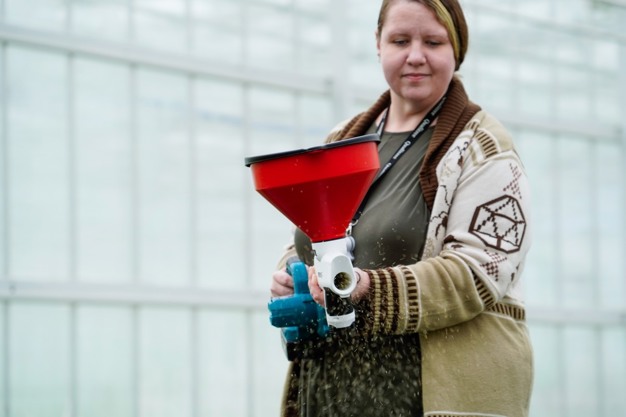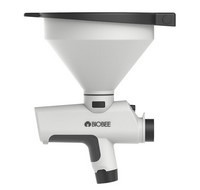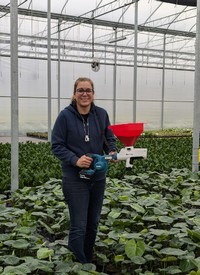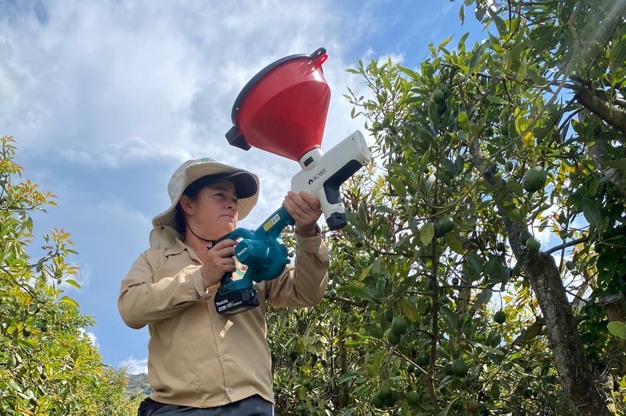
"For growers using biological pest control, achieving uniform distribution of beneficial organisms, such as predatory mites, has historically been challenging. Conventional methods, including manual scattering ("chicken feeding"), often result in uneven coverage. This inconsistency can lead to pest hotspots, jeopardizing the success of an integrated pest management (IPM) program," says Skirma Dab, a representative of BioBee Biological Solutions in Canada.
Photo right: Skirma Dab, a representative of BioBee Biological Solutions in Canada
According to him, other companies have been working on solutions, but their biggest problem is insect mortality and inconsistent flow rates. "The flow of release or method to spray these organisms is too strong, leading to a high mortality rate of your beneficial predators."
BioBee was founded in 1983 in Kibbutz Sde Eliyahu, Israel. They have been specializing in mass rearing, implementing, and applying tools for beneficial insects and mites for biologically based integrated pest management in agriculture and bumblebees for natural pollination for over 40 years.
Uniform application of beneficial organisms
"Growers would often find that some areas were left unprotected, creating room for pest outbreaks," Skirma adds. "BugFlow was developed to address the limitations growers faced with traditional dispensers," he explains. "It's not just about efficiency—it's about giving growers a reliable tool to strengthen their biological programs." BugFlow's rotor-based system offers precise calibration of application rates, minimizing mite mortality to just 3-4%. "If I know I need five mites per square meter, I can adjust the rotor speed and my walking pace to match that requirement," he explains. This level of precision minimizes waste and ensures that every square meter receives the intended dose of beneficial organisms.

BugFlow being used at Qualitree propagators Inc.
Designed for grower convenience
BugFlow's design is practical and tailored to the needs of growers. Skirma recounts how feedback from users led to significant improvements in the device. "Initially, the nozzle length posed challenges in greenhouses, especially when navigating around posts or densely planted crops. We shortened the nozzle, which solved the issue and allowed for even, uniform application."
"The fine-grain carrier used in BioBee's products works seamlessly with BugFlow, allowing for uniform and rapid dispersal across large areas," says Sirma. With a reach of three meters forward and 50 centimeters to each side, the device is particularly suited for crops on benches, bedding plants, and other hard-to-access areas.

Easy use of BugFlow in narrow rows
Another important addition is the funnel attachment, which enables the mixing and application of up to three liters of different biological agents in a single operation. This feature has been beneficial for growers dealing with multiple pest challenges simultaneously, allowing for broad-spectrum applications without the need for separate passes. Growers can combine solutions like BioStratio and BioSwirskii to target pests at different life cycle stages simultaneously.
BugFlow's compatibility with most off-the-shelf blowers (MAKITA, DE-WALT, MILWAUKEE, and the popular Makita DUB185Z), makes it accessible to a wide range of users. BioBee is also developing an adaptor that will enable growers to attach cylinders directly to the device, further streamlining operations.

The choice of carrier material for beneficial insects also developed to suit BugFlow's capabilities. Traditional peat moss carriers used for soil-dwelling mites like Hypoaspis were replaced with a sawdust-based medium. This modification improves the device's performance in targeting soil pests, such as thrips pupae, while maintaining its versatility across different pest control scenarios.
Photo right: BugFlow device
While BugFlow has proven effective in traditional crops, BioBee is exploring new markets, including mushrooms. BioStratio, housed in an organic, sterile carrier, is one such product in development. "The same fine-grain carrier used for mites makes BugFlow an ideal tool for dispersal in mushroom cultivation," Skirma notes.
Efficiency in greenhouses
BugFlow's impact is particularly evident in controlled environments, where precision and efficiency are important and space can be limited. It caters to growers with diverse needs. Its six adjustable dial settings (ranging from 2 to 12 RPM) enable precise control of application rates. "For instance, if you're working with dahlias prone to thrips, you can quickly increase the release rate to ensure optimal protection," Skirma explains.

Nurseries like Bevo Farms, Qualitree, and Van Belle have adopted BugFlow, praising its ability to save labor while ensuring consistent pest control. "Chicken feeding bios in a large facility is a pain," Skirma adds, noting the inefficiency of older methods. He highlights an example of a large pepper grower who adopted the device. "What used to take an entire day with the manual application now takes just two hours using four BugFlows. The time savings are incredible."
Photo right: BugFlow used in Van Belle
This reduction in labor also means significant cost savings. Growers often find that the device pays for itself within weeks of use. "The efficiency it brings to operations allows farmers to redirect their labor force to other critical tasks," Skirma notes.
BioBee is also exploring BugFlow's potential in open-field applications. Crops like grapes and hops present unique challenges due to their scale and accessibility. "We are currently working on integrating BugFlow with drones to achieve faster and broader coverage in these crops," Skirma shares.
However, drone technology will come with its own set of challenges, particularly wind dispersal when applying fine materials from the drones. "We are collaborating with other companies to address these technical issues, and the initial results are very encouraging," Skirma adds.

BugFlow used in open-field
Labor and sustainability advantages
The labor-saving capabilities of BugFlow align with other trends in sustainable agriculture. As chemical pesticide regulations tighten and consumer demand for eco-friendly practices grows, biological solutions are gaining traction.
"Growers are limited in what they can spray chemically, which is driving the demand for biological solutions," Skirma observes. He also emphasizes how BugFlow reduces the environmental footprint of pest control. By ensuring precise application, the device minimizes the risk of overuse and waste, which can harm non-target organisms and ecosystems. This precision enhances the overall health of agricultural systems and biodiversity.
Collaboration and developments
Feedback from growers has been really helpful in refining the device, from its nozzle design to its carrier compatibility. "Our growers are our partners in innovation," says Skirma. "The combination of precision and efficiency is helping growers reduce pest outbreaks while promoting healthier crops," he concludes.
BioBee has 7 subsidiaries (Canada, USA, Mexico, Colombia, Peru, Chile, and South Africa), and 5 production sites, and is active in over 100 markets through its various distribution channels.
For more information:
Biobee Biological Solutions, Canada Inc
Skirma Dab
linkedin.com/in/skirma-dabulevicius
biobee-canada.com
1 (519) 933 0648
[email protected]
